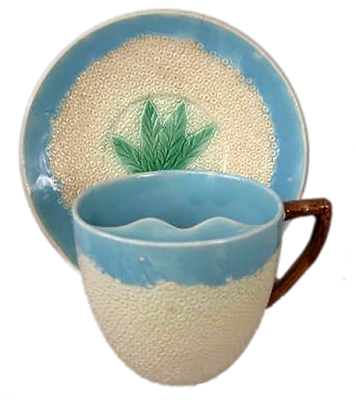As a former antiques dealer, I've heard this phrase so many times over the years.
Victorians had customs and a culture long since forgotten by contemporary collectors of majolica. Hence the phrase, "What the heck is that?" often shows up when a piece with Victorian symbolism or a piece with an unknown use surfaces on the market. People need to be reminded that Victorians lived in a different world than us, one rich in symbolism and manners. In one of my books on majolica, Etruscan Majolica: The Majolica of Griffen, Smith and Company, The Catalog I did an entire chapter explaining the Victorian Language of Flowers. So common in the iconography of majolica, it is difficult to ignore the reoccurring flower themes and other images found in it.
Take for example the Holdcroft pitcher shown above. Most people looking at it haven't got a clue what it is. That's because the meaning of the object has disappeared with time. At the time it was made however, anyone seeing the pattern would have been charmed immediately by it. Most modern viewers have no way of knowing that it is an early Christian symbol of fertility and mortality, one commonly referenced in the 19th Century. Resurrected by Oscar Wilde with his Aesthetic Movement fairy tales published in the 1880's and collected together in a publication in 1891, The House of Pomegranates the image became a part of the popular culture. That information has been lost to time.
Yes, the pitcher above is representative of a pomegranate! It's not immediately apparent that the peeled back "skin" of the pitcher is revealing pomegranate seeds, especially with the mottled brown and green color of the pitcher. What's worse is when the piece is seen in turquoise or cobalt, which it frequently is. Then it takes quite a bit of imagination to see the real meaning of the piece. But the pitcher was not really meant to stand alone. This pattern was made in many different shapes from tiny butter chips to a large punch bowl. When one views some of the other pieces of the pattern the meaning is a bit more apparent.
Holdcroft majolica pomegranate pitcher
Holdcroft majolica pomegranate mustache cup & saucer
Holdcroft majolica pomegranate butter pat
Holdcroft majolica pomegranate plate
Holdcroft majolica pomegranate teapot
Holdcoft pomegranate butter dish
The teaware and butter dish even have a tiny pomegranate as a finial if someone somehow missed the point. Seen in a large group it is a charming and powerful pattern. That is something that is rarely seen these days as there aren't very many Holdcroft collectors in the majolica world.
So the next time you're tempted to say, "What the heck is that?" put the piece in the context of the time in which it was made. That will give you the clues you need to find an answer.













No comments:
Post a Comment